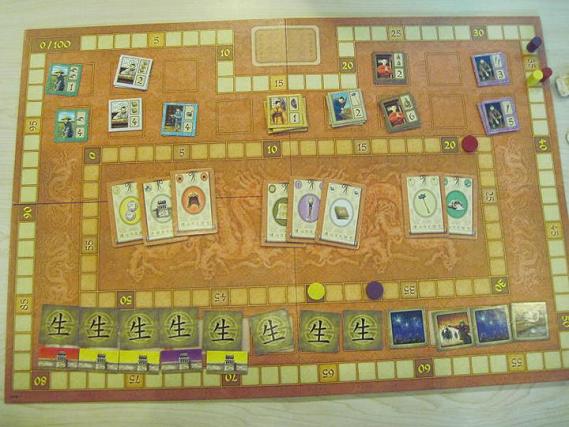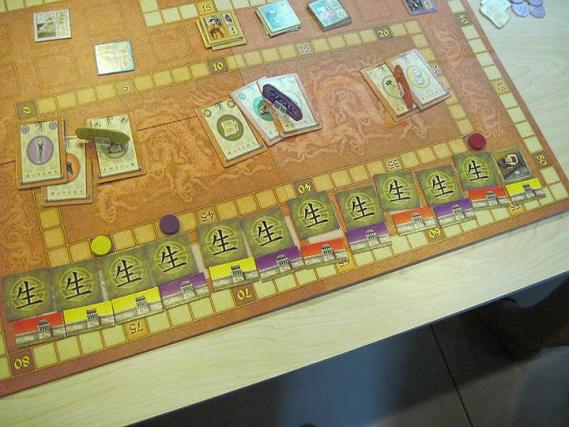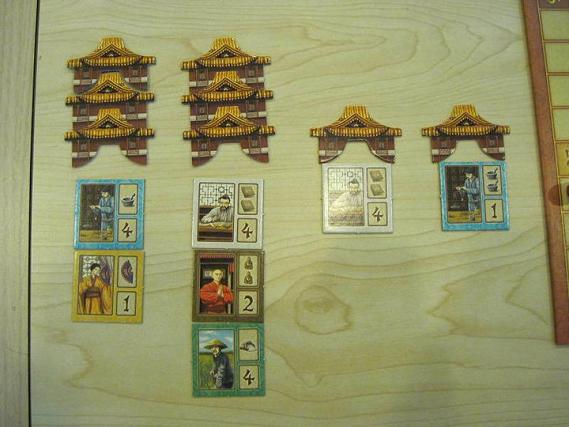
We recently played In the Year of the Dragon again, this time using the Great Wall of China mini-expansion included in the Alea Treasure Chest. Naturally, as we’d gotten the rules wrong the first time around, we made certain this time that only one action out of each selected group could be performed. The box actually included another mini-expansion for this game, called Superevents, which consisted of nothing more than a set of special event tiles, out of which one would be chosen to take effect in the seventh month of the year. Apparently one of Sean’s magazines counseled against it, so we skipped that one. It sounded lame to us anyway.
The components comprising the Great Wall expansion consists of a set of six Great Wall tiles in each player color and a new action tile. The action tile is mixed in with the other tiles and represents a new type of action that players can select. The player who elects to take this action selects one of his Great Wall tiles, immediately gets the benefit printed on its reverse side and then places the tile as a completed wall section beneath the row of events. The Great Wall is always constructed from left to right and have the same width as the event tiles, so completing the Great Wall requires twelve sections to be built.
Each of the six different Great Wall tiles offers a different benefit, which is usually equivalent to the effects of one of the regular actions, except that it can’t be boosted by having workers. So you have a tile that gives you one Rice, one that allows you to build one Palace level, one that gives one Firework and one that gives two Yuan. In addition, one of the tiles gives you three Victory Points, virtually guaranteeing that every player will want to build this wall section at some point in the game, and the last one, if I recall correctly, allows you to advance three spaces along the person points track.

The incentive to make sure that the construction of the Great Wall goes well goes beyond these benefits however. One rule change that comes along with the wall is that the Mongol Invasion events now have much more bite. When one these come up, players must check if the Great Wall has caught up to that space. If it has, each player scores Victory Points equal to the number of wall tiles he has contributed. If it hasn’t, then the wall fails to keep out the invaders and the player who contributed the least wall tiles loses one person. This is in addition to the normal effects of the Mongol Invasion event, so in our session when it happened, I lost one person due to tying for the lowest number of Military icons and another one for contributing the least wall tiles.
At the end of the game, the Great Wall is again evaluated in the same manner, either scoring points for each player according to the number of wall sections he has contributed, or causing the least patriotic player to lose a person. This means that in theory wall sections can score points for their builders three times over the course of the game, while providing them with an alternative but weaker method of gaining resources when the primary actions are blocked.
In our session, we neglected building wall sections at the beginning of the game as our distribution of events placed most of the disasters that required resources to overcome in the early part of the year. It just seemed more efficient to take the regular actions to deal with the disasters. Sean did build a wall section early but didn’t seem inclined to build more until we started to catch up on him. In fact, for most of the game, we thought that we would never finish the wall at all and both Mongol Invasions had to be faced with an insufficiently long wall. Later on, as we felt less need to get resources or to build palace levels, we started to build more wall sections and ended up finishing it anyway.

Sean led the way through most of the game by fighting hard to get and keep the starting player position and buying a Two Privilege tile on the first turn. I tried to put pressure on him on the Person Point track but gave up near the end of the game. The two persons Shan chose to start out with didn’t give her many Person Points and she despaired for a while about whether or not to try to catch up. On my advice, she eventually resigned herself to be last and went only for the older and more powerful persons, even taking a Lady very early. This turned out badly for her and she blamed me for it.
Still, I contend that it’s workable strategy, provided that the last place player can get enough money to pay three yuan to select actions from groups that have already been taken. In our game however, both the Taxes events came up quite early, so the money raising action was always occupied, preventing her from getting a good store of cash with her two Tax Collectors. As for me, I declined to buy Privileges and fell behind both of them by quite a lot, but after getting two Researchers, I quickly caught up using the Research action but ended up losing to Sean slightly as I had forgotten that he had one last Firework.
In retrospect, this game was the perfect opportunity to try the Double Build strategy often talked about on BGG as both Famines happened early and no one was interested in taking the Building action later. This involves getting two Builders and taking the Build action often to build empty palaces. They would decay by a level every turn, but as long as one level remains you can still get an extra point per turn.
Anyway, I greatly enjoyed this session of In the Year of the Dragon. I regret that I’m still not quite ruthless enough to cut people loose left and right, but jousting with Sean over the first player position was a lot of fun and we had a lot of tension as the action tiles were distributed as it was quite obvious what each of us wanted. I find the Great Wall expansion to be excellent as well. I’ve always thought that the Mongol Invasion was sort of a boring event and this certainly makes it something to fear. At first, I thought that having access to the benefits from the wall tiles would make life a bit easier as it’s now harder to be completely blocked from something, but everyone needs to contribute to the wall for it to get built and the penalty for failure nicely balances out the additional action choice. In short, if you have this mini-expansion, there’s really no reason whatsoever to play without it.
3 Responses to “In the Year of the Dragon”
“This turned out badly for her and she blamed me for it.”
I agree on this one… i also blame you :p Staying behind strategy i think is only for experts after 10th play…
Not my fault! She was the first to choose and picked Tax Collector and Farmer (7 person points). I think I picked Farmer and Soldier (9 person points). I can’t remember if you had 9 as well or went up to 10. At the end of the first turn, I think you picked another high number to prevent me from catching up with you, so I think she had no chance of catching up to first place at all. She could fight with me for second place, but I don’t know if that would be worth it.
I think I did some mistakes myself, especially didn’t count the money properly, which gave me very bad consequences. But I still blame him for purposely choosing something to block me and building the wall in order to kill one of my person!
Leave a Reply